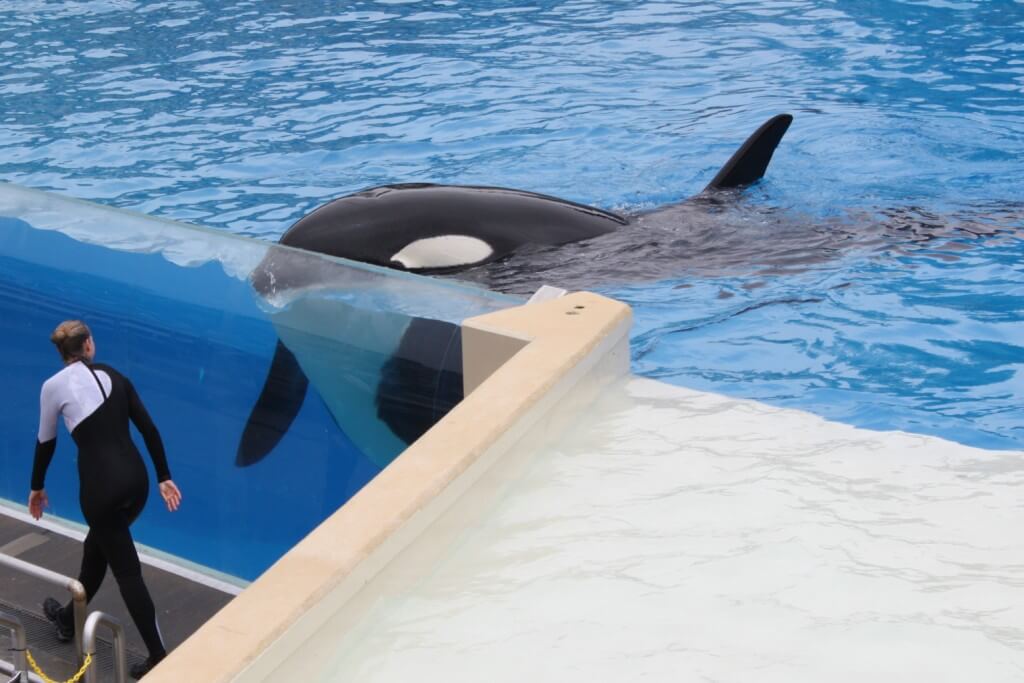If you celebrated Christmas as a child in the ’70s, you remember your favorite Christmas presents. You may have gotten a Stretch Armstrong, a Pet Rock, a Nerf ball, or even a handmade scarf. However, Corky—torn away from her mother when she was just 4 years old—has now missed out on 53 Christmases with her family. She’s been held in captivity longer than any other orca in the world.
Corky has missed out on the most basic gifts of nature for most of her life. Here are four important things she’s been denied:
1. Room to Roam
Individual orcas have been recorded traveling up to 150 miles per day. They can dive up to 1,000 meters and spend 95% of their time submerged. In nature, they swim almost continuously.
Like all orcas held at marine parks, Corky is confined to a tiny concrete tank. She may have lost the opportunity to swim free with her pod because of the vicious humans who abducted her, but she could thrive in a seaside sanctuary.
If SeaWorld traded her glass and concrete enclosure for a sea pen—a stretch of ocean, where she could swim free—Corky would be a lot more comfortable.
2. A Home That Doesn’t Hurt
Do you have memories of being comfortable and cozy in your home during Christmas? Corky doesn’t. Ever since her capture, she’s been trapped in awful marine park enclosures.
Corky’s tiny SeaWorld tank is an assault on all her senses. She’s constantly subjected to loud noises and blaring music at SeaWorld, and there’s little doubt that the stress of extreme confinement negatively affects her health. She’s fed dead fish, instead of capturing live prey as she would naturally, and she has severe dental damage from chewing on the concrete and metal that imprison her.
The ocean is Corky’s natural environment. It isn’t filled with loud humans. In a seaside sanctuary, if Corky ever felt the need to chew on something, she’d have better options.
3. Dignity and Bodily Autonomy
After Corky was traumatically ripped away from her mother, marine park employees used her as a breeding machine. She was bred with her own cousin six times at the now-defunct Marineland of the Pacific, but none of her babies even survived as long as two months.
These are the stories of her tragic pregnancies.
February 28, 1977: Corky gave birth to the first live calf born in captivity. The male calf failed to nurse, and he died of pneumonia after about two weeks.
October 31, 1978: Corky’s second calf, named Spooky because he was born on Halloween, was born. He also failed to nurse and died of pneumonia. It’s believed that the formula he’d been fed was contaminated.
April 1, 1980: Corky gave birth at eight weeks to a premature stillborn calf.
June 18, 1982: Corky’s longest surviving baby was born. She lived for just 46 days and also failed to nurse. After about a month, Marineland of the Pacific reportedly feared for the calf’s safety because Corky had become increasingly rough with her, so the calf was placed in a separate tank. She died a couple of days later.
July 22, 1985: Corky gave birth to a female calf, who survived for only about a month.
July 27, 1986: Corky’s last pregnancy at Marineland of the Pacific ended in a miscarriage.
August 1987: Corky miscarried her last baby, who was found dead at the bottom of her tank at SeaWorld. After this miscarriage, Corky stopped ovulating and was unable to have any more children.
The physical and mental toll these pregnancies took on Corky was almost certainly immense. SeaWorld may have stopped trying to breed her, but it hasn’t stopped using her in performances. She’s still forced to perform tricks for public amusement, when all she deserves are peace and control over her life.
4. Opportunities to Make Lasting Friendships
Corky is doubtlessly tormented by her loneliness in marine parks. It makes sense: Orcas are highly social animals. Most orca populations live in stable social groups with strong long-term associations, and some individuals, such as mothers and sons, stay together for life. SeaWorld utterly disregards the importance of orcas’ families and friendships, instead confining these majestic animals for human amusement.
When Corky shared a tank with Orkid, a young female at SeaWorld, she clung by her side. It could be that Corky missed her own calves and embraced the opportunity to act like Orkid’s mother.
However, this behavior may have aroused the jealousy of Orkid’s mother, Kandu.
Kandu started charging at Corky while they were in the same tank and broke her own jaw when she rammed into a wall, severing arteries in her head. It took 45 minutes for Kandu to die while Orkid helplessly watched.
If Corky were transferred to a seaside sanctuary, she might be able to communicate with her pod—a vital lifeline she will never have in a marine park.
Corky’s Spent 53 Christmases Suffering, so Help Give Her the Ultimate Gift
Everything that Corky needs most would be found in a seaside sanctuary, but SeaWorld hasn’t made any plans to place her in one—that’s where you come in.
Please take just a moment to urge SeaWorld to implement a definite and immediate plan to release Corky into a seaside sanctuary. With your help, we can give her the best Christmas present of all—the freedom to live more naturally and in peace.
The post 4 Gifts Corky Hasn’t Had for 53 Christmases appeared first on PETA.

